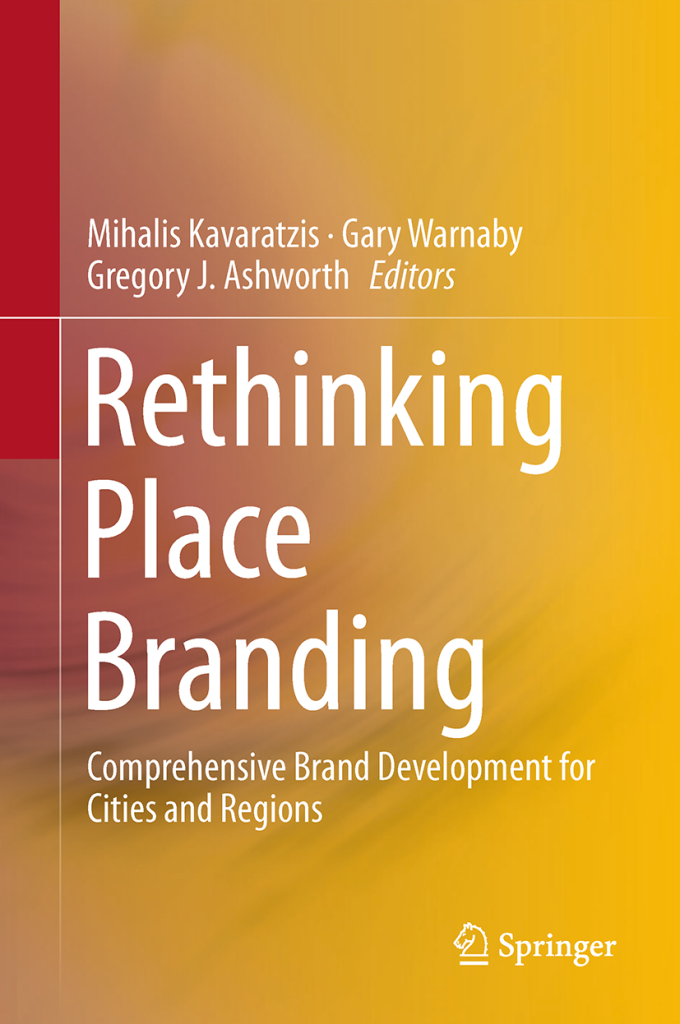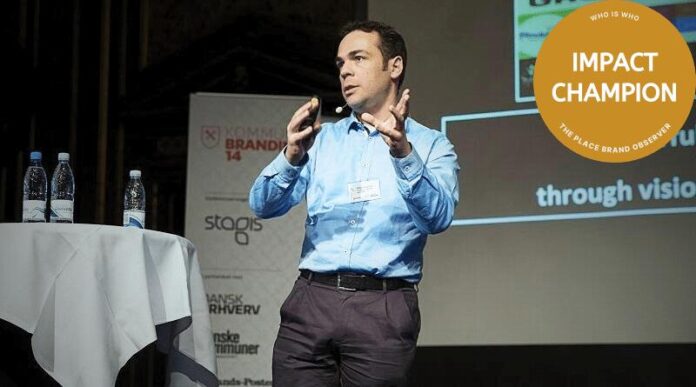Mihalis Kavaratzis, Senior Lecturer in Marketing at the University of Leicester (UK) and adviser on place marketing and city branding, in this interview discusses why we need to rethink place branding and what motivated him to co-edit the book Rethinking Place Branding: Comprehensive Brand Development for Cities and Regions.
Learn about:
- Why place branding is like listening to the life-stories of places;
- Why places need to understand and pay attention to their brands more than ever before;
- Why collaboration and citizen engagement is the most important part in place branding;
- How branding provides a general strategic guidance for place management;
- Key challenges: Which issues city- and regional authorities struggle most with;
- The key insights from the book Rethinking Place Branding;
- How to measure the effectiveness and success of place branding initiatives.
Mihalis, what fascinates you about city brands and destination branding as research topic?
What I find fascinating is the myriads of new understandings of place management and place development that open up when we think of places as brands and place management as an exercise of attempting to influence peoples’ perceptions of places.
What place branding helps us with is the appreciation that these perceptions are results of complex processes of interactions between the physical and the mental, between the functional and the emotional, between the real and the imaginary, and between the individual and the collective.
Place branding is like listening to the life-stories of places, and this I find fascinating and extremely rewarding.
What motivated you to co-edit the book Rethinking Place Branding?
The shared motivation, together with my co-editors Greg Ashworth and Gary Warnaby, was our belief that the place branding field has reached a stage in its development where it is necessary to undertake a general re-thinking of what it is we are talking about, what it is that places can gain from branding, what it is that we have learned so far and what it is that we need to consider in the future.
We felt that it is time to look back at the accumulated knowledge of the last two decades, see how things have changed, and how we need to proceed if we want to further advance the theory and practice of place branding.
We also wanted to address the major misunderstanding of a place brand for a logo or slogan, which has plagued the field for too long…
We wanted to raise the questions that are important to be addressed and initiate a dialogue that might lead to a refined understanding of place branding. There was no such book in the market and we hope that some might find it interesting and useful, and might engage in this dialogue.
What is the book about?
We have collected new contributions from several leading commentators. We asked each contributor to write a commentary on one of the several aspects that need such a re-consideration. Various topics are discussed from a new appreciation of the origins of the field, to assessing its contribution to place development.
We discuss issues around culture, sense of place, stakeholders, measurement and many more. All contributors are experts on the specific topic that their chapters deal with and this gives the book a certain sense of ‘the right people talk about the right things’.
There are, of course, several more commentators that could have usefully contributed and perhaps other issues to add to the list but we feel that, given the limited scope of a single book, we have achieved a good coverage of topics.
 What are the key insights from the book?
What are the key insights from the book?
I think that the main lesson I have learned from the book is a new understanding of the changing environment in which places are undertaking their branding. The changes have to do with the internet and digital technologies, but also with changes in our appreciation of the relationship between the place brand and the people who matter more for place branding: the place’s residents.
I personally find that the book provides very useful insights on both the theoretical basis of a multi-disciplinary and more responsible place branding practice, as well as the practical consideration of the ways in which people use all sorts of technology and ‘know-how’ to participate in the creation of the place brand.
All this is coupled with new suggestions on the processes involved in place branding and their effects, which makes – in my mind at least – a very interesting reading.
How important are city brands in the 21st century?
I think more than ever! Places need to understand their brands and pay attention to them more than ever before. This is not only because of the intensified competition, which sometimes becomes a meaningless game for places, but, more importantly, because all place users understand places as brands, so if place authorities want to form and maintain a meaningful relationship with them, they need to think in the same terms.
But again, this means understanding the full complexity of a place brand and its dynamics, rather than approaching it as a simple promotional activity.
In your view, how can place branding be used for social cohesion, active citizenship and the sustainable development of cities or destinations?
The key word here is participation. It is all about allowing, facilitating and encouraging peoples’ participation in the construction of the place brand.
We need to give them the means and the reasons to get involved in the story that their place is telling on their behalf. In this way, place branding becomes a powerful tool for development and cohesion.
This does not mean that we will be able to find a single story or the ‘one’ claim that we will all agree to and advocate. Place brands consist of multiple stories told simultaneously by different people.
The beauty of places is that they allow so many different stories to develop, so many lives to be lived at the same time.
What we need to understand is that often the process is more important than the outcome. The minute we ask people to tell us their own place story, we have already started the branding process. And it is precisely this multiplicity of the place story that brings people to tourism destinations as well. They want to join in.
How can branding be best applied to place management?
In my view, branding provides a general strategic guidance for place management. Place branding is capable to identify the main collective vision for the future of the place. This is the effect and consequence of a participatory place branding process.
This vision can be the aim for all marketing and development efforts. This is a holistic and integrated view of place branding that, although not everybody agrees, is becoming more and more popular.
Place branding provides strategic guidance, assists in linking to people and makes them feel closer connected to the place. For this to happen, branding needs to be the responsibility of many organisations and people across the place.
How to measure the effectiveness of place branding?
Difficult question! Several consultants have developed their own methods to measure and evaluate place brands, but the truth is that, while all have their own merits, none has been convincing enough to become widely accepted.
Two chapters of Rethinking Place Branding look at this. The first is by Sebastian Zenker and Erik Braun, who discuss the measurement of place brands. The second chapter is by Magdalena Florek on place brand equity.
Why are place branding strategies relevant to the social existence of places?
If the strategy is in the right spirit (i.e. the spirit of inclusiveness, participation and collaboration), then it helps with cohesion and with civic pride.
People feel that they share brand ownership and this makes a difference in their own lives and their connection to their place of residence or origin.
At the same time, of course, they also become more active citizens and stronger ambassadors for the place. If the strategy is one of promotional nature only (i.e. a new logo or a new identity claim of the sort of ‘we are the capital of the world’), then it has an adverse effect on the local population who don’t have this sense of ownership and they cannot connect. This disconnects them from their place and from its authorities as well.
We describe the links between place branding and local development in the Place Marketing Manifesto that we wrote for the Best Place Institute.
Which are the key challenges in destination branding?
Destination branding is a very challenging activity. It is easy when disconnected from the place brand and misunderstood as the development of a catchy slogan. However, this is not the real benefit of destination brands.
The main thing is understand that place and destination cannot be distinguished and to treat them as one – and this is something that in the contemporary environment is very difficult because it goes against existing structures and thus brings many people outside their comfort zone.
Another challenge is to see the real value of the destination brand for the visitor. As people become more and more well-travelled, they increasingly use destination brands in the own identity construction and in their projections of their image.
So destination branding is not a case of bringing people to the destination only. The important thing is to give them something that they can use for their own purposes. This again is very challenging.
Judging by your experience as place brand adviser, which issues do city and regional authorities, tourism offices etc. struggle most with?
In my dealings with local authorities, I find that the two main challenges are misconception and fragmentation. When they call me from City Halls and Tourism Offices, they usually say: “we want to develop a place brand, so can you please tell us what colour we should use on the font?” And I have to explain that they called the wrong person. This is not what place branding is about.
The few that call me back usually exclude from our meetings the Tourism Office or the Economic Development Department or the Communications Department. And I have to persuade them to work together because the place brand will be for the place, not for their own organisation.
The problem is that many consultants take advantage of this situation of misconception, which harms the place branding field.
 Your advice for city and regional authorities how/where to find suitable place branding specialists?
Your advice for city and regional authorities how/where to find suitable place branding specialists?
There are plenty of specialists around and they are not difficult to find. Of course, some are real and some not, some are responsible and some not. I have seen good work from several consultants and I know several of them personally.
My first advice is for local authorities to organize a workshop on place branding before you write bids and offer projects. This is the kind of consultancy I like to do, giving people a sense of what they should be aiming at and what they should expect from their place branding project. They always find it very useful and it saves a lot of time and effort.
The second advice is to make use of consultancy services offered by universities, particularly in Europe. Those are most of the times much cheaper than private consultants.
Thank you, Mihalis.
Connect with Mihalis Kavaratzis on LinkedIn.
Enjoyed our interview with Mihalis Kavaratzis on why we need to rethink place branding? Spread the word!


